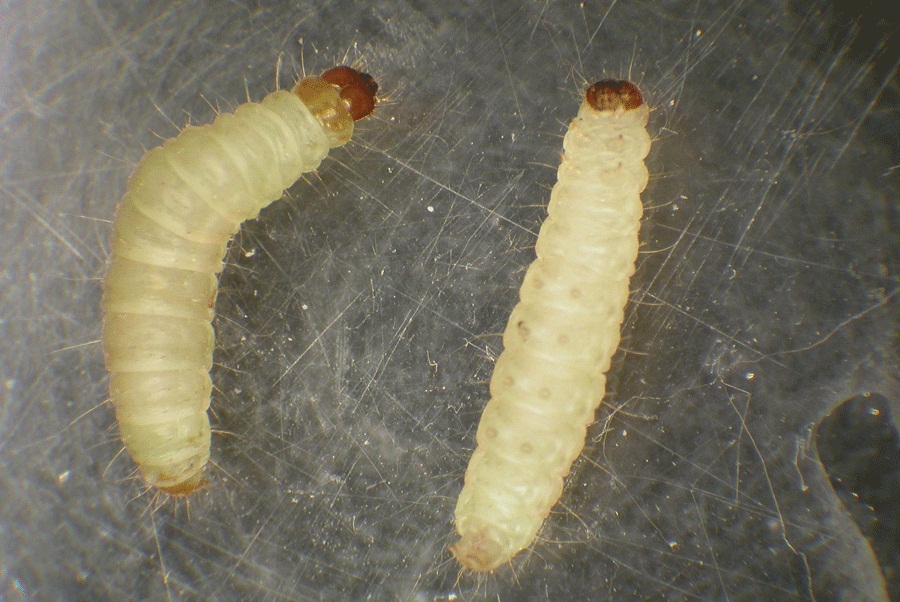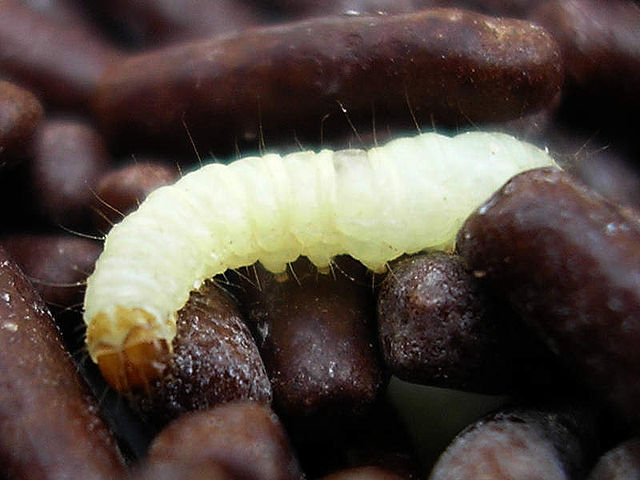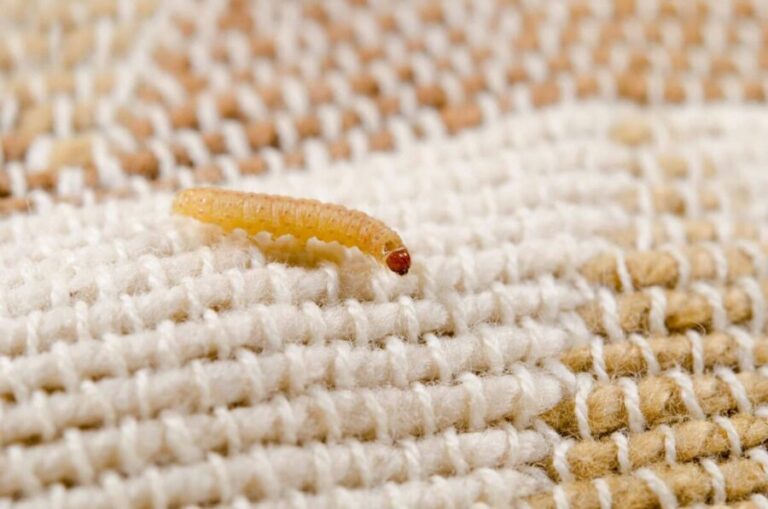Moths do not come from maggots. Moths go through a life cycle that includes four stages: egg, caterpillar (larva), pupa, and adult. Maggots, on the other hand, are the larvae of flies, and their life cycle is entirely different.
How do moths develop?
Moth development, from humble egg to delicate winged adult, is a remarkable journey guided by nature’s intricate processes.
Four stages of the moth life cycle
Egg: The moth life cycle begins with the egg stage. Female moths lay tiny, usually oval-shaped eggs, often near a suitable food source for their future caterpillars.
The number of eggs laid can vary depending on the moth species but typically ranges from a few to hundreds.
The eggs are usually adhesive, allowing them to stick to surfaces such as leaves, stems, or even the ceilings of buildings.
Caterpillar (larva): After the eggs hatch, they give rise to caterpillars, also known as larvae. This is the growth and feeding stage of the moth life cycle.
Caterpillars vary in appearance depending on the species but often have cylindrical bodies with segmented sections.
They have chewing mouthparts and feed voraciously on plant leaves or other suitable food sources, growing rapidly.
Caterpillars often have distinct patterns, colors, and structures that can help with camouflage and protection from predators.
Pupa: When the caterpillar reaches a certain size and developmental stage, it undergoes a remarkable transformation into a pupa.
The pupa is a non-feeding, often cocooned or enclosed stage where the caterpillar’s body undergoes a complete overhaul.
Inside the pupa, the caterpillar’s tissues break down and reorganize into the structures of the adult moth.
This transformation includes the development of wings, legs, and other adult features.
Adult: The final stage of the moth life cycle is the emergence of the adult moth from the pupa. The adult moth typically has two pairs of wings, a segmented body, and specialized mouthparts for feeding (which can vary depending on whether the moth is designed for nectar-feeding or not).
The primary purpose of the adult stage is reproduction. Moths seek mates, often using pheromones to locate each other. Once mated, female moths lay eggs, starting the cycle anew.
Description of each stage:

Egg: This is the initial stage where the female moth deposits eggs on a suitable substrate, ensuring a food source is available for the emerging caterpillars.
Caterpillar (larva): Caterpillars are the most active and conspicuous stage of the moth’s life cycle. They feed extensively, storing energy for their later transformation into an adult.
Pupa: The pupal stage is a period of transformation and development, marked by profound physiological changes as the caterpillar transitions into an adult moth.
Adult: The adult moth is the culmination of the life cycle. It is equipped for reproduction, often featuring specialized structures for finding mates and, in some cases, nectar-feeding.
What is the maggot life cycle?
Maggots are the larval stage of flies. They are soft-bodied, legless, and usually cylindrical in shape. Maggots are often associated with decomposing organic matter, such as food waste, carrion, or dung, where they play a crucial role in breaking down and recycling organic material.
Fly species vary, and so do their maggots in terms of size, color, and feeding habits.
Maggot life cycle:
Egg: The life cycle of a fly typically begins when an adult female fly lays eggs, often near a suitable food source.
The number of eggs laid can vary greatly among fly species and environmental conditions. The eggs are usually small, oval or elongated, and can be laid individually or in clusters.
Larva (Maggot): Once the eggs hatch, they give rise to larvae, commonly known as maggots. Maggots are the feeding and growing stage of the fly’s life cycle. They have specialized mouthparts for feeding on decaying organic matter, which may include bacteria, fungi, and the material they were laid on.
Maggots grow rapidly during this stage, molting several times as they increase in size.
Pupa: As the maggot reaches a certain size and maturity, it undergoes a transformation into the pupal stage.
The pupa is often a non-feeding, inactive stage, during which the maggot undergoes metamorphosis.
Inside the pupa, the larval tissues are reorganized into the structures of the adult fly.
Adult fly: The final stage of the fly life cycle is the emergence of the adult fly from the pupa.
Adult flies have two wings, six legs, and a pair of antennae.
They are equipped for reproduction and often have specialized sensory organs to detect suitable mating partners and food sources.
Once mated, female flies can lay eggs, starting the life cycle over again.
Comparison with moth life cycle:
| Aspect | Flies | Moths |
| Number of Life Cycle Stages | Three stages: egg, larva (maggot), adult | Four stages: egg, caterpillar (larva), pupa, adult |
| Pupal Stage | Yes, but with less tissue transformation | Yes, with significant tissue transformation |
| Larval Diet | Feed on decaying organic matter (detritivores) | Feed on plant material (herbivores) |
| Adult Adaptations | Focus on reproduction and often pollination | Focus on reproduction and play roles in pollination and other ecological interactions |
What are the differences between moths and maggots?

The differences between moth and maggot life cycles:
Moth Life Cycle:
- Egg Stage: Moths start their life cycle as eggs, often laid on or near their future caterpillar’s food source.
- Caterpillar (Larva) Stage: Caterpillars are the growing and feeding stage of moths. They feed on plant material and have distinct body structures for this purpose.
- Pupa Stage: During the pupal stage, caterpillars undergo complete metamorphosis, where their tissues reorganize to form adult structures, including wings.
- Adult Stage: Adult moths emerge from pupae, often with wings for flying, and their primary role is reproduction.
Maggot Life Cycle (Fly):
- Egg Stage: Flies lay eggs, usually near decaying organic matter, like food waste or carrion.
- Larva (Maggot) Stage: Maggots are the larval stage of flies and are specialized for feeding on decaying organic material. They lack legs and have distinct mouthparts for this purpose.
- Pupa Stage: Similar to moths, flies have a pupal stage, but it involves less tissue transformation compared to moths.
- Adult Fly Stage: Adult flies emerge from pupae and have two wings, six legs, and antennae. They primarily focus on reproduction and, in some cases, pollination.
Highlight that moths do not come from maggots:
It is crucial to emphasize that moths and maggots are entirely different organisms with distinct life cycles.
Moths are a type of insect that undergoes complete metamorphosis, while maggots are the larval stage of flies, which have a simpler life cycle.
Moths do not go through a maggot stage, and maggots do not transform into moths.
Maggots are often associated with decomposing organic matter, whereas moths are diverse insects with various ecological roles, including pollination and herbivory.
Understanding these differences is essential in fields like entomology, ecology, and forensics, where accurate identification of insects and their life stages is crucial.
FAQ’s
What kind of worms turn into moths?
Caterpillars, not worms, turn into moths. Caterpillars are the larval stage of moths.
What insect do maggots come from?
Maggots come from flies. They are the larval stage of various fly species.
How do you get rid of moth maggots?
To get rid of moth maggots, remove the contaminated food source, clean the affected area, and consider using natural remedies or insecticides.
What turns into a moth?
A caterpillar turns into a moth through a process called metamorphosis, which includes pupation.
What kills maggots easily?
Soapy water or a mixture of vinegar and water can be effective in killing maggots easily.
What kills maggots instantly?
Boiling water or bleach can kill maggots instantly when poured directly on them.
How long do maggots live for?
The lifespan of maggots varies depending on factors like temperature and food availability. On average, they live for about 5-14 days in the larval stage.
Final Words
In conclusion, a comprehensive understanding of the life cycles of both moths and maggots is crucial for various fields, from etymology to ecology and forensics. Moths undergo a fascinating transformation through four distinct stages: egg, caterpillar (larva), pupa, and adult.
This complex metamorphosis allows them to occupy diverse ecological niches and play essential roles in ecosystems, including pollination and herbivory. In contrast, maggots, as the larval stage of flies, follow a simpler life cycle with three stages: egg, larva (maggot), and adult fly.
These legless, feeding larvae are often associated with the decomposition of organic matter. It is paramount to emphasize that moths do not come from maggots; these are entirely distinct organisms with separate life cycles.

